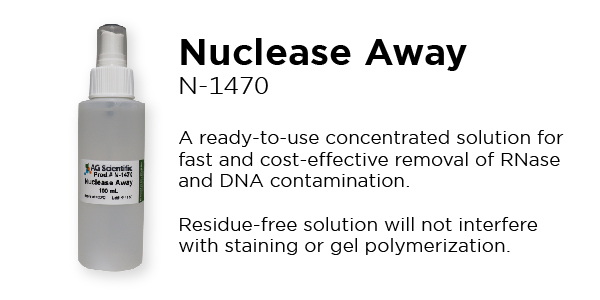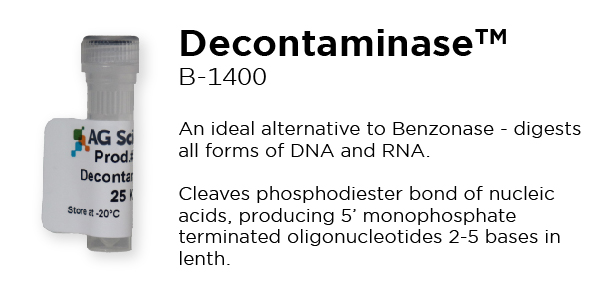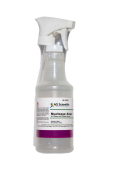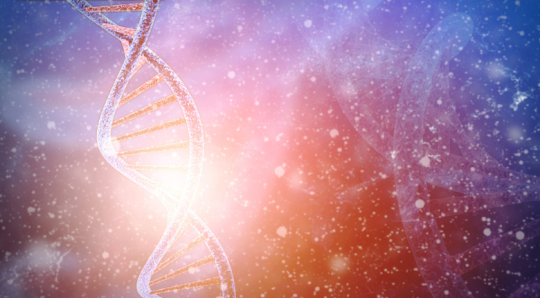The polymerase chain reaction (PCR) technique, used to amplify or “copy” small segments of DNA, is highly sensitive - and that’s a good thing. PCR is a widely used and inexpensive technique used in medical diagnostics, forensic analysis of DNA, and genomic research. Unfortunately, this sensitivity leaves PCR vulnerable to nucleic acid contamination: even trace amounts of DNA can be amplified, compromising the quality of your data and leading to false-positive results. Given the potential harms that DNA contamination can cause, from incorrect diagnoses to financial ramifications for laboratories, DNA-typing laboratories must take every precaution to avoid contamination.
Potential sources of DNA contamination
Contamination occurs with the introduction of exogenous DNA. The most impactful sources of exogenous DNA in DNA-typing laboratories are the analyst’s DNA, DNA from other samples, and DNA fragments of the allelic ladder used to determine the size of amplified alleles.
1. Sample to sample transfer
This is the most common source of contamination at the pre-amplification stage. Sample to sample contamination occurs by transferring a small amount of one sample into another. Common sources include incorrect handling techniques, reagents, and disposable supplies. Other potential causes of cross-contamination between samples are damaged containers and failure to decontaminate sampling tools.2. Cross-contamination between nucleic acids
Cross-contamination between nucleic acids is a significant hurdle for PCR laboratories because sources of contamination are diverse and often unexpected. Risk factors for nucleic acid contamination include:- Reagents
- Disposables and equipment such as sterilized bronchoscopes and reaction tools
- Environmental contaminants
- Insufficient communication between neighboring laboratories and among different research groups within a building
3. Amplified material carryover
Amplified material carryover is when previously amplified material contaminates the next batch of samples. Given the remarkable sensitivity of the amplification process, this is the most significant contamination source in DNA-typing laboratories.How to prevent DNA contamination in your lab
1. Ensure good QA/QC by optimizing laboratory layout
The layout of your lab makes it easy to keep your pre-PCR and post-PCR areas separate. Ideally, these two areas should be different rooms with airlocks between them to reduce the potential for contamination. If this is not possible, special care must be taken so that dedicated equipment, from refrigerators to pipettes, are used for each area. Similarly, ensure a unidirectional workflow from pre-PCR to post-PCR to prevent equipment like racks and pipette tips and PPE from returning to the pre-PCR area following amplification.2. Zero in on PPE
Personal protective equipment (PPE) is a potential source of contamination. PPE includes items such as gloves, lab coats, eye protection, and shoe covers. Non-disposable PPE like lab coats and eye protection must be cleaned regularly to prevent contamination. Disposable items like gloves should be changed regularly, and PPE dressing areas for pre and post-PCR must remain separate and ideally be located at the entrance and exit of each area.3. Perfect your pipetting technique
Pipetting has the potential to introduce foreign DNA to your sample if you do not use proper technique. The incorrect pipetting technique can cause splashing and aerosol contamination when dispensing liquids. To ensure your pipetting best practice, take a look at these pipetting technique videosby Anachem.4. Clean lab surfaces and equipment with a nucleic acid removing agent
Scheduled routine cleaning with a nucleic acid removing agent is paramount to prevent contamination. Cleaning your workspace before starting a procedure will also minimize the potential for contamination.AG Scientific offers two nucleic acid decontamination solutions: Nuclease Away is ideal for decontaminating apparatus, bench-tops, glassware, and plasticware in the event of DNase and RNase contamination.

Decontaminase is an alternative to Benzonase that digests all forms of DNA and RNA, including single and double-stranded, linear, circular, and supercoiled. To learn more about Decontaminase, please see our online brochure.

5. Include controls in your protocol
Including appropriate controls in your PCR protocol aids in determining whether DNA contamination has occurred. A negative control reaction or “no-template” control (NTC) helps determine if contamination is from reagents. Including a positive control can also be useful in identifying contamination.The Takeaway
Preventing nucleic acid contamination is vital for generating accurate and reproducible data. To avoid DNA contamination, keep your pre and post PCR areas separate, change your PPE frequently, and regularly disinfect your workspace and equipment.Additional Reading
- 6 Reasons to Change Control with Manufacturers
- 7 Procurement Problems in the Chemical Industry
- 7 Sources of Antibiotic Resistance


